One thing often overlooked in e-commerce is the power of well-crafted product descriptions. Typically, they are bland, simplistic, and, frankly, inadequate. Let’s look at an example of a practical product description. Imagine browsing the internet, visiting your favorite online stores, and spot the perfect pair of pants—precisely what you had on your wish list. The fit appears great, and the color is just right, but there’s a snag: you can’t tell what the material is. There’s no product description.
Would you go ahead and buy it?
Maybe not.
Now, consider a different scenario, briefly mentioning the material and care instructions but with no engaging product description. You hesitate, set it aside, and keep looking. Soon, you find another pair of pants that looks similar but comes with a captivating product description that highlights the style and vibe of the item. It connects with you on a personal level, doesn’t it? You’re much more likely to purchase this second pair simply because the description resonated with you.
A compelling description can transform a simple browser into a buyer. Effective product descriptions do more than inform; they persuade. They should evoke emotions, answer questions, and reflect the customer’s needs. Product descriptions allow the browser to imagine a fantasy and visualize themselves with the product.
That is why retailers can significantly enhance customer engagement and conversion rates by enriching product descriptions with vivid details, lifestyle contexts, and specific benefits.
Product descriptions will significantly enhance your SEO performance and set the brand’s tone, making each product seen and felt.
What are Product Descriptions

When you look at different product description examples, you will find they are all inconsistent in how they create product descriptions. Some highlight the benefits, some use it to give instructions, or most small retailers don’t use it. However, one thing is for sure: they are a crucial element of e-commerce and marketing communications.
Product descriptions provide potential customers with essential information about a product’s features, benefits, and use—not just one, but all of them. Don’t forget that people almost always do their research to buy things, and they are willing to read things to learn about the products. Product descriptions should be executed to inform, persuade consumers to purchase, and reflect the brand’s tone.
Let’s examine the key elements that define what product descriptions typically include and why they are important:
Product Features
You should always include basic information about the product, such as size, materials, color options, technical specifications, and any other relevant physical attributes. This is the factual part of the description that tells consumers what the product is. Sometimes, you can see them as a picture or as it is integrated into the text. However, this is crucial information that you must always include in your product descriptions.
Benefits
Effective product descriptions go beyond listing features by explaining how those features benefit the user. When writing the benefits, you should always aim to make the reader imagine how the product works in real life. Make them imagine a scenario or incorporate storytelling elements to connect the product’s features to the customer’s needs or desires.
Usage Instructions
Some products might be technically more complex than others. And including instructions will be crucial in this case. They will describe setting up the product, care instructions, or safety guidelines.
If you want to create product descriptions that captivate and persuade the shopper to buy your products, ContentGo AI is a great tool that will elevate your content game.
You will find multiple templates that will cater to your product description needs and create your descriptions in minutes!
Sign up today to captivate your target audience with product descriptions that align with your brand, mesmerize your customers, and persuade them.
Why Product Descriptions Are Important
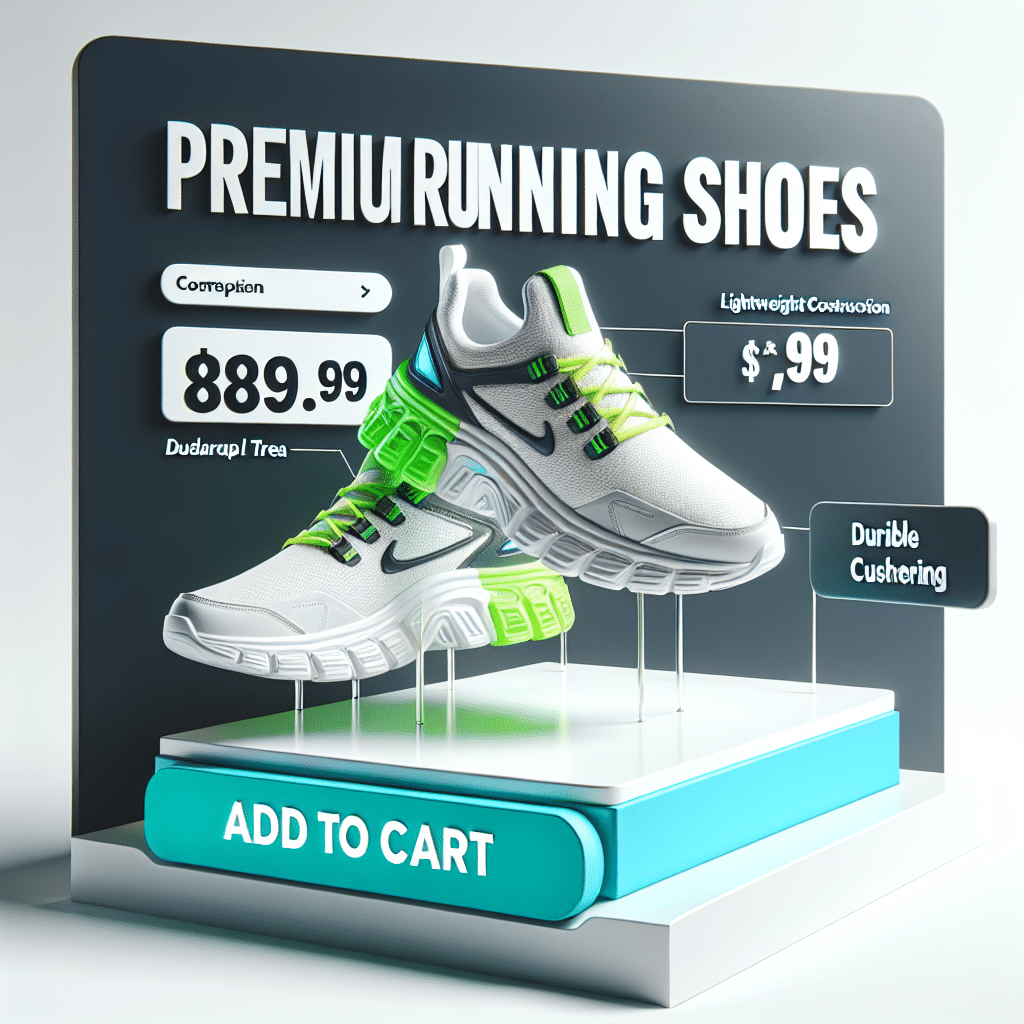
Product descriptions are important because they act like your shopping assistant online. They help you make choices and clarify questions as you decide what to buy.
Let’s look at a smartphone product description example. A good product description includes more than just features like camera quality, battery life, and screen size. It explains how these features make the phone better for your daily use. It might point out that the high-quality camera is great for taking photos wherever you are or mention that the fast-charging battery is convenient for people who are always moving. This helps potential buyers imagine how the phone could be helpful in their lives, answering their questions about how it works and why it’s a good fit for them. It also enhances the user experience on e-commerce platforms.
Precise and accurate descriptions also minimize customer confusion and dissatisfaction, reducing the likelihood of returns. When customers feel confident that the product they buy aligns with the description they read, trust in the retailer grows.
A simple and effective product description can also excite you about buying the latest gadget by showing how it can make your life easier or more enjoyable. This way, it tells you about the product and encourages you to buy it.
How to Create Product Descriptions
You must have a clear idea of creating product descriptions by now. But let me remind you again that every word should serve a purpose: to inform, persuade, or connect emotionally with your audience. Any product description example you encounter should effectively balance these three elements, ensuring that they work together to enhance the overall impact of the message.
Remember these tips when you are writing product descriptions;
1) Know who you are writing for
Usually, your target audience’s demographics, psychographics, or behavior patterns will be consistent across all of your products, but they might change with each product. So, you should craft your product descriptions with a clear understanding of your audience’s needs, preferences, and pain points. In fact, the best way to know who you are writing for is creating buyer personas. Buyer personas are fictional representations of your ideal customers based on real data and market research. They help you humanize your target audience, giving insights into their motivations, challenges, goals, and buying behaviors.
You can gather information from surveys, interviews, and social media to make these personas. Then, give each persona a name, age, job, and story. Describe their goals, challenges, and what they like about your products. This is a bit detailed way to approach this whole process, but if you want to be effective and have fun by getting to know your audience, this is the way! Plus, you will also greatly benefit from creating buyer personas in your content marketing efforts.
2) Focus on clarity and be concise
Nobody wants to come across a page long complicated text when they are considering to buy a product. Everyone wants to know the details of the product and how it will benefit them in their life instantly. Remember, in today’s fast-paced digital world, attention spans are short, so capturing your audience’s interest quickly is crucial. Utilize bullet points, short paragraphs, and clear headings to enhance readability and keep your descriptions focused and to the point. Customers should be able to scan your descriptions quickly and grasp the key benefits and features of the product.
By being clear and concise you will effectively communicate the essential information without confusing or overwhelming your audience. This might become a little bit hard considering that you should also create a sense of vibe while writing your product descriptions but that is where the art of copywriting comes into play.
Good copywriting balances clarity with creativity, conveying the benefits and features of your product in a way that grabs attention and resonates with your audience. It’s about finding the right words to evoke emotion and drive action while keeping things succinct and to the point.
The goal is to make it easy for customers to imagine themselves using your product and experiencing the benefits it offers. By striking the right balance between clarity and creativity, you’ll create product descriptions that not only inform but also inspire and persuade.
3) Keep your brand tone consistent through all of your product descriptions

Whether professional, playful, luxury, or economical, how a description is written can reinforce the brand’s message and appeal to its target audience. That’s why when the tone and style of a product description reflect the brand’s identity, it becomes a branding element that not only communicates product specifics but also solidifies the brand’s personality in the minds of consumers.
4) Include product features, benefits, instructions
A comprehensive product description should not only list the features of the product but also highlight, unique selling points, benefits and provide any necessary instructions or usage guidelines. Features describe the tangible characteristics of the product, such as size, color, material, and specifications. Benefits, on the other hand, explain how these features solve problems or fulfill needs for the customer. For example, instead of simply stating that a vacuum cleaner has a powerful motor, you would emphasize the benefit of efficient cleaning and time-saving. Including instructions or usage guidelines helps customers understand how to use the product effectively and can reduce the likelihood of returns due to misunderstandings.
5) Use sensual language, create emotional engagement
Good product descriptions can evoke emotions and create a connection with the shopper. By using persuasive and engaging language, descriptions can make the product feel essential, desirable, or unique. For example, imagine a product description for a luxury cashmere sweater. Instead of simply stating its material and fit, the description could read, “Wrap yourself in the unmatched comfort of our plush, handwoven cashmere sweater. Each thread promises warmth and a whisper of timeless elegance, perfect for those serene winter evenings or sophisticated social gatherings. Experience the embrace of luxury that looks exquisite and feels like a second skin.”
It’s almost like a beautifully crafted passage from a novel that transports you directly to the glamorous event. Such descriptions are designed to elevate the product beyond its physical attributes, creating a compelling emotional response that can decide to purchase.
6) Incorporate storytelling elements
When you come across a product description example that incorporates storytelling elements to the product, the product might become irresistible to buy. These product descriptions might describe how soft fabric feels, how sturdy an item is built, or the subtle fragrances of a product, enhancing the tactile and sensory appeal. Or they can include the story of the product’s origin, how it was made, or a scenario that paints a vivid picture of its potential use.
The sensory details the context, and the story connect you with the object, and the best part is that you can actually buy the object of desire.
7) Optimize for search engines
Including relevant keywords in a product description helps draw organic traffic to a product page from potential customers searching for that product or related items.
SEO for product descriptions often involves very specific, long-tail keywords that potential customers might use when they are close to making a purchase decision. For instance, instead of targeting broad terms like “shoes,” a product description might target “women’s waterproof hiking boots size 8.”
Another thing you should consider adding to your product descriptions is related questions about the product. You can answer potential questions a buyer might have about the product or look for long-tail keywords that are questions about your product. This includes its uses, benefits, and why it stands out from competitors, which helps match users’ specific search queries.
Crafting SEO-optimized product descriptions for a small brand may seem relativelyeasy. However, for larger companies, this task often presents a formidable challenge.
If you are searching for a tool to streamline your keyword research, conduct SERP analysis, integrate insights into your briefs, and effortlessly generate bulk content, you are in the right place.
Sign up today and effortlessly craft high-quality, SEO-optimized product descriptions in mere minutes, and scale up your content creation without limits!
Want to see how it works?
8) Incorporate social proof such as reviews or testimonials to build trust and credibility
When potential customers see positive reviews or testimonials from satisfied buyers, it reassures them that your product is of high quality and delivers on its promises. These reviews show your product’s value, helping to overcome any skepticism or doubts your potential customers might have. Be careful when choosing reviews. Choose the detailed and genuine ones, and place them where they’ll have the most impact in your description. You can even include pictures or videos to make them more convincing. By sharing these real-life stories, you’re giving your potential customers more confidence in your product and making it easier for them to purchase.
9) Always proofread and edit your descriptions for grammar, spelling, and clarity before publishing
Perfect grammar is all about credibility. Sure, no one will shoot you if you have errors, and some visitors might not even notice them, but if they remain, they will slowly but surely decrease the credibility of your brand. By prioritizing proofreading and editing in your product description process, you ensure that your content is professional, engaging, and effective at driving conversions.
Typos, grammatical errors, and misspelled words can make your descriptions appear unprofessional. Customers may question your products’ quality or your company’s reliability if they notice careless mistakes. By thoroughly proofreading for grammar and spelling errors, you demonstrate attention to detail and a commitment to excellence.
10) Include calls-to-action encouraging customers to explore further or purchase without delay
Customers may feel unsure about what to do next without a clear CTA after reading your product description. It sounds counterintuitive, considering it is a product description, and you are supposed to buy the product, but it’s true. Including a CTA provides clear guidance and prompts them to take the next step in their purchasing journey. It creates a sense of urgency, encouraging customers to act quickly rather than procrastinate or leave the site without making a decision. Phrases like “Shop now,” “Limited time offer,” or “Buy before it’s gone” can motivate customers to make a purchase sooner rather than later.
5 Best Product Description Examples
1- Apple AirPods Pro
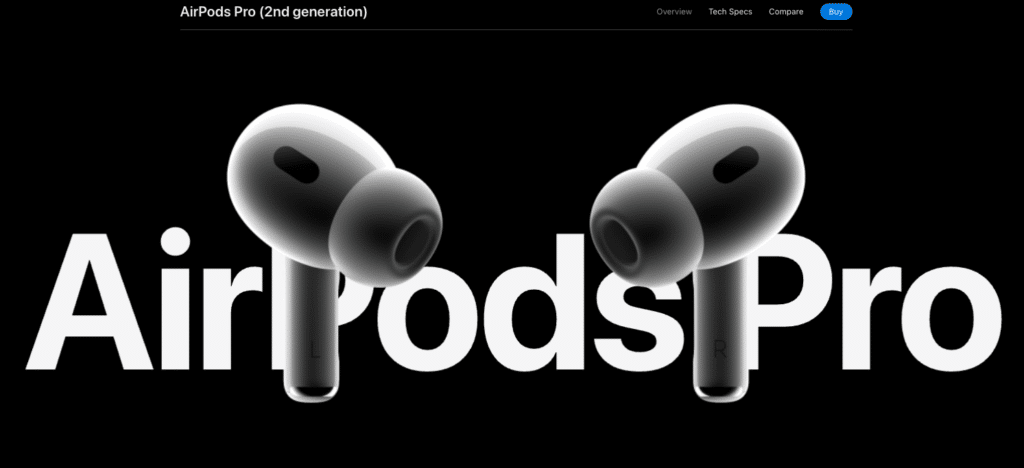
Being the marketing geniuses of our times, Apple creates mesmerizing and captivating product descriptions that make their products seem like rock stars. This product description example illustrates how they turn a simple piece of technology into an essential part of the user’s lifestyle.
The product description appeals to sensory experiences, aligns the customer’s life goals with product benefits, and uses simple yet powerful language stripped of excessive technical jargon. The choice of words plays a significant role in crafting an emotional response that aligns with the product’s branding as innovative, reliable, and indispensable. Perfectly executed.
2- Instant Pot Duo 7-in-1 Electric Pressure Cooker
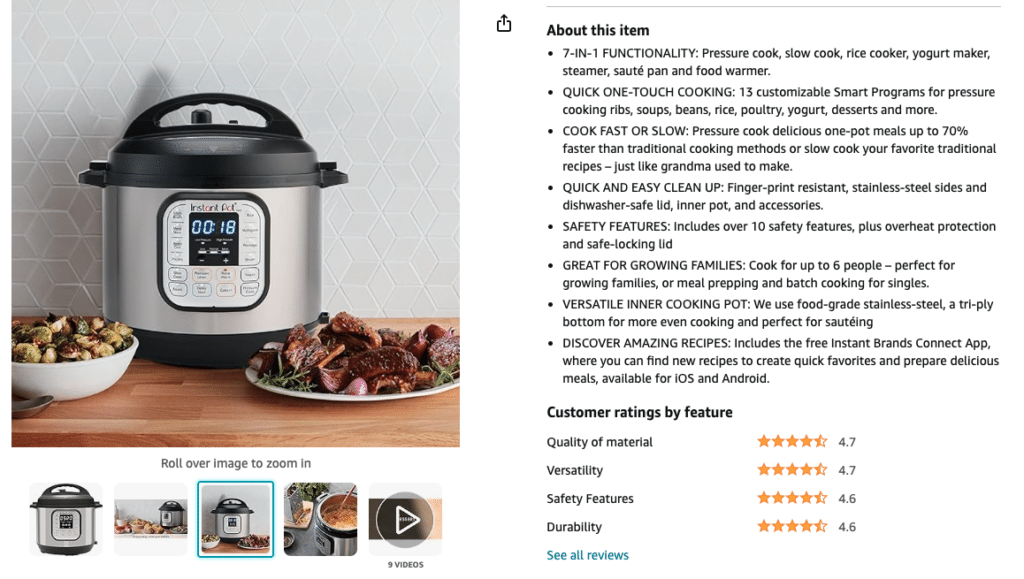
The product description for the Instant Pot Pro 6-quart Multi-Use Pressure Cooker on Amazon stands out for several compelling reasons.
Tip: If you want to learn how to write Amazon product descriptions, you can visit our related guide.
First, it masterfully highlights the key benefits and features in a way that directly appeals to its target audience. By emphasizing the cooker’s speed, efficiency, and versatility, it addresses the practical needs of busy individuals and families seeking convenience in their culinary endeavors.
Second, the product description example also cleverly positions the Instant Pot Pro as a 10-in-1 appliance, appealing to those looking to declutter their kitchen with a single, multi-functional tool. The description sells a solution. And lastly, the inclusion of positive customer reviews leverages social proof. The clarity and directness of the language used to make this description accessible to a broad audience, ensuring that the benefits and features are easily understood.
3- Nike Dunk Low
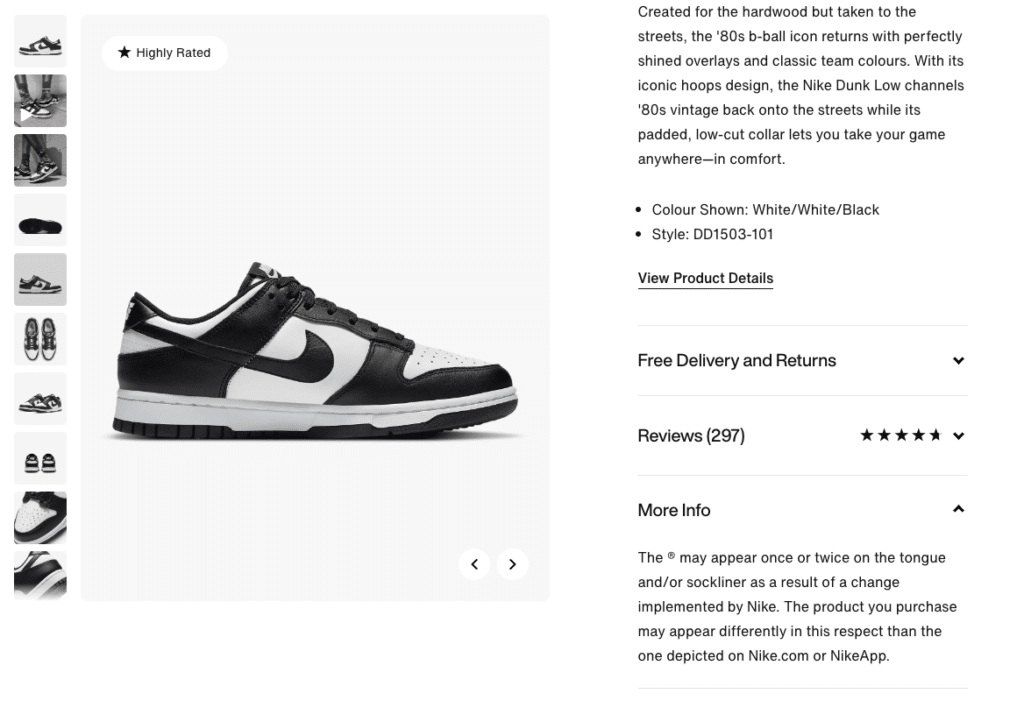
Another marketing genius, Nike, provides one of the best examples of product descriptions with its effective blend of storytelling, quality emphasis, and consumer engagement. By weaving the sneaker’s rich basketball heritage with its modern streetwear appeal, the description connects emotionally with a diverse audience, from sports enthusiasts to fashion-forward individuals.
The durable leather materials and unique denim-inspired accents highlight the sneakers’ premium quality and distinctive style, setting them apart in a competitive market.
4- Dyson AirWrap
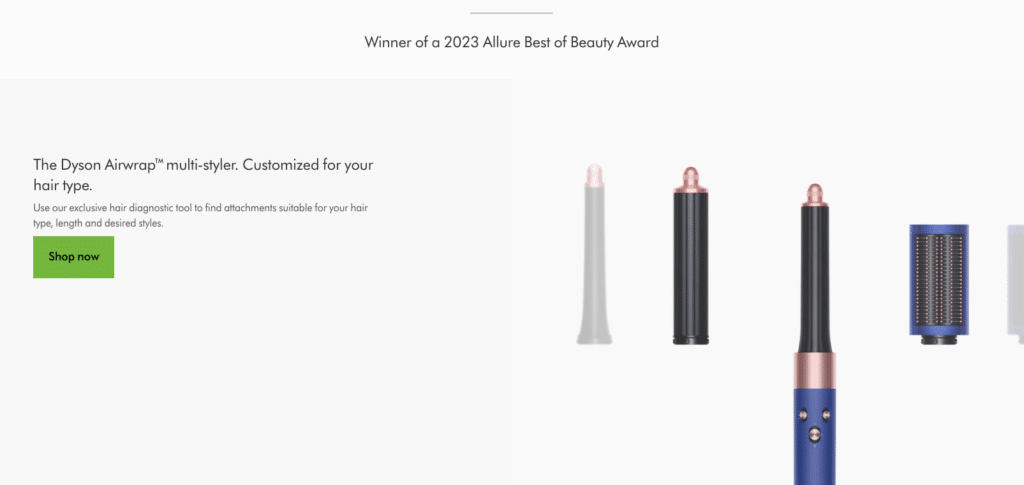
The product description example for the Dyson Airwrap Hair Styler is one of the best because of its holistic and strategic approach. It successfully captures the essence of the product through a focus on innovative technology, specifically highlighting the Airwrap’s ability to style hair with minimal heat, which protects hair health. The description educates consumers on the unique Coanda effect, enhancing its appeal by merging scientific innovation with practical utility.
5- Sony PlayStation 5 Console
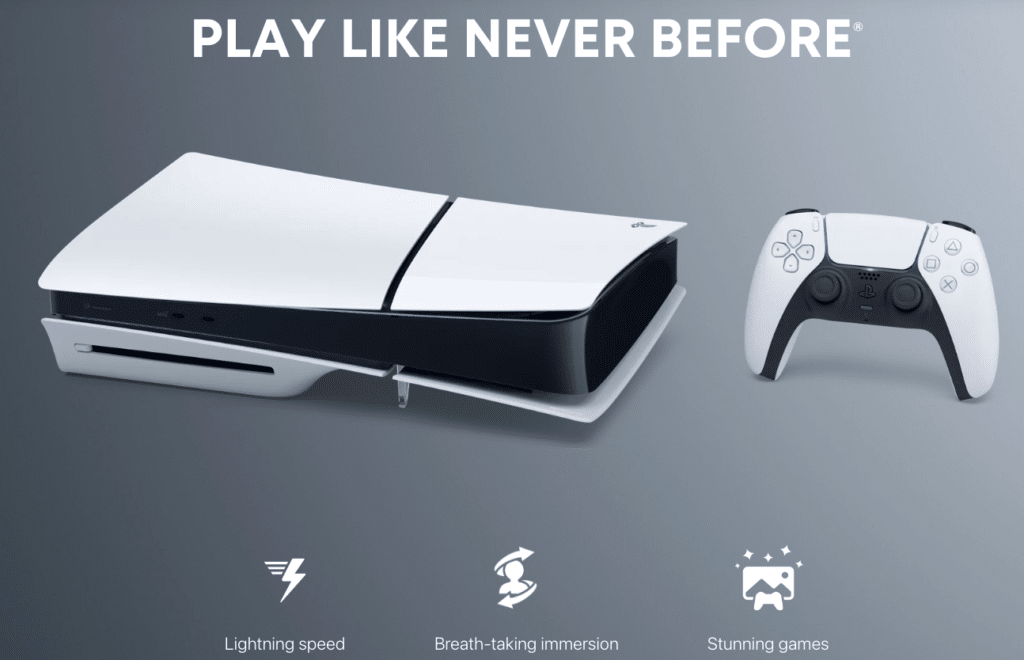
The PlayStation 5 description does a fantastic job of showing off what the console can do while making it super appealing and accessible to everyone, no matter where they are. It uses a mix of tech details and cool gaming features to really grab your attention and get you excited about this console’s capabilities.
It also points out the PS5’s cool design, making it clear that this console looks as good as it performs. Plus, it doesn’t just stop at good looks and great tech. The PS5 promises many new games, appealing to longtime PlayStation fans and newcomers alike. Everyone’s included, whether in Tokyo, Toronto, or Texas, making it feel like you’re part of a big global community of gamers. This makes it a top-notch example of how to write about a product to get people really interested.
Product Description Template
As businesses grow and expand their product ranges, product description templates make managing large volumes of product descriptions easier. Templates provide a foundation you can easily scale; however, you should customize them sufficiently to ensure each product description feels unique and tailored.
If you are managing extensive inventories or multiple product lines, here is a free template that you can use:
[Product Name]
Introduction:
Start with a captivating opening line that sums up your product’s main selling point. Keep it concise and focused on what sets your product apart. The shorter the better.
Who It’s For:
Be specific about who will benefit most from using it and how.
What It Does:
Feature 1: [Brief description] — Explain how this makes the user’s life better or solves a problem.
Feature 2: [Brief description] — Highlight the innovation or technology involved.
Feature 3: [Brief description] — Point out ease of use or how it fits into daily life.
Why You’ll Love It:
Benefit 1: [Explanation] — Connect emotionally, showing the feel-good factor or the efficiency it brings.
Benefit 2: [Explanation] — Discuss the quality and durability.
Benefit 3: [Explanation] — Mention environmental benefits or cost savings over time.
How to Use It:
Give a brief overview or steps on how to use the product effectively. These can be practical tips or creative ideas to encourage usage.
Technical Specifications:
Provide a bullet list of technical details like dimensions, materials, technology specifications, etc., to inform users who seek depth.
Customer Reviews:
Feature a couple of positive customer reviews that reinforce the product’s value and effectiveness from a user’s perspective.
Special Offers:
If applicable, mention any current promotions, discounts, or special offers related to the product.
Call to Action:
Encourage the reader to take action, such as “Buy Now,” “Sign Up,” or “Learn More,” with a link or instructions on how to proceed.
Satisfaction Guarantee:
Close with quality satisfaction assurance, like a money-back guarantee, warranty, or customer support services.
If you are looking for a tool that offers free templates like this, ContentGo AI is a tool that helps with fast and high-quality product description creation.
You can easily customize and create your templates and unique product descriptions in bulk.
Sign up for ContentGo AI today and take your e-commerce marketing to the next level!
